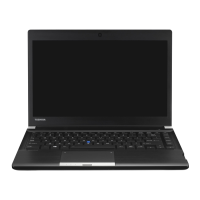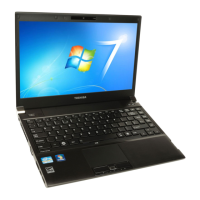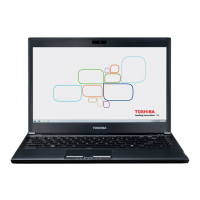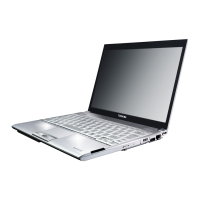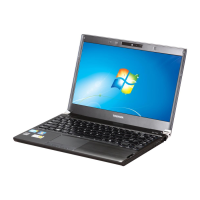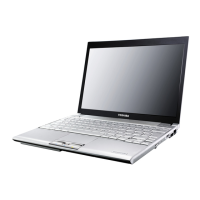
Do you have a question about the Toshiba PORTEGE R300 and is the answer not in the manual?
Lists essential hardware and documentation components for new users.
Step-by-step guide for charging the battery and powering the computer via AC.
Instructions on how to safely open the LCD display panel to a comfortable viewing angle.
Procedures for turning the computer on, starting it for the first time, and shutting it down.
Methods for resetting the computer, including soft and hard restart procedures.
Identifies and describes components visible on the computer's front when the display is closed.
Details the various ports and connectors located on the left side of the computer.
Outlines the ports and features found on the right side of the computer, including card slots.
Explains the meaning of the LED indicators that show the computer's operational status.
Details CPU models, memory slots, and video RAM allocation for system performance.
Covers built-in Modem, LAN, Bluetooth, and Wireless LAN capabilities for connectivity.
Lists and describes optional devices like PC Cards, SD Cards, and Battery Packs to expand functionality.
Guide on controlling the on-screen pointer and using touch pad buttons for navigation and interaction.
Instructions for enrolling, swiping, and managing fingerprints for system security and logon.
Procedures for cleaning the computer and precautions for moving it safely to prevent damage.
Explains different power conditions, battery status, and indicator lights for AC and battery power.
Details on handling, charging, extending life, and replacing the computer's battery pack.
Information on setting up and using User, Supervisor, and HDD passwords via the TOSHIBA Password Utility.
Describes Boot Mode, Standby Mode, and Hibernation Mode for managing computer power states.
Guide on launching the HW Setup utility to configure hardware settings and system features.
Instructions on setting the order of devices for the computer's boot sequence.
Steps for entering, navigating, and saving changes within the BIOS setup utility.
Guidelines for effectively identifying and resolving computer problems by observing and documenting issues.
Solutions for common problems related to keyboard, modem, LAN, wireless, and Bluetooth connectivity.
Procedures and regulations for safely disposing of the computer and its rechargeable batteries.
Details on the Wireless LAN card's form factor, compatibility, and data transmission rates.
Overview of Bluetooth wireless technology interoperability, health considerations, and regulatory statements.
